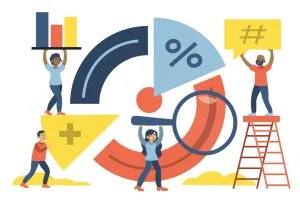In the realm where unmatched amounts of data are generated, the ability to transform complex data into understandable, clear insights have become paramount for critical decision making. In the battle of text content vs visual content – visual is the clear winner. They can create impact and present data in graphs, charts, scatter plots, Venn diagram, Histogram and more. Here’s where data visualization comes into light. They fill the gap between raw data and actionable insights.
Moreover, there are some of the best data visualization tools available, and here we’ve put them down. The tools should be user-friendly, versatile and give the go to visualize data, fostering efficient and effective communication. Let’s delve in further to know more!
Advantages of Data Visualization Tools
While we’ve seen the overview of data visualization tools, there are some of the key advantages to using it. For example, whether you’re showcasing the data to your clients, vendors, or stakeholders, visual representations make it easy to seize their attention and unlock business insights.
Time and Cost Savings
The tools for data visualization don’t let you spend hefty amounts of time and money. With the user-friendly interfaces, pre-built templates, the process of data visualization is made super easy. Thus, rest assured your business can analyze data quickly and get insights that human brain can adapt well.
Easy to Analyze Trends
Trends take over the market anytime. With the best tools for data visualization, you can analyze the recent trends and patterns in data. This way, you can analyze current events and predict future events, such as a decline or growth in sales over a certain period.
Data Exploration
Data visualization tools offer you interactive features that let you explore data in-depth. You can filter the data, change visualizations and do much more. This will enable deeper understanding of the data.
Best Data Visualizations to Use in 2024
Tableau
An ideal and popular visual analytics platform that enables individuals and IT business leaders to see, analyze and work on data. With Tableau organizations can accelerate innovations, boost operations and better serve their customers.
One of the significant features is Tableau allows you to connect with different data sources, including databases, spreadsheets and other big data sources. Thereafter, craft compelling dashboards that present visual representation of raw data. Tableau has different versions like server, web-based and customer relationship software management.
Pros of Tableau
- User friendly
- High-class performance
- Mobile friendly
- Has a community
Power BI
The next on the list of the best data visualization tools is Microsoft Power BI. It’s majorly known for the seamless integration with Microsoft’s products and services. This is a dynamic tool for data-driven decision making, as it offers different visualization options, interactive dashboards and more. Power BI is mainly used by organizations that rely on the Microsoft environment.
Pros of Power BI
- Top-class security
- Personalized, user-friendly dashboards
- Easy integration with existing apps
- Works well with Microsoft products and services
Zoho Analytics
Zoho Analytics is one of the widely used business intelligence and data visualization tools that lets you create compelling data visualizations and insightful dashboards in a few minutes. Further, the analytics solution helps to track key performance metrics, discover insights and make future predictions.
Pros of Zoho Analytics
- Import data from different data sources
- Offers features for transforming and enriching data
- Instant customer support
- More room for data
Google Charts
One of the prominent players in the data visualization market is Google Charts. It’s coded with HTML 5 and SVG. Google charts is popularly known for creating pictorial and graphical data visualizations. It’s compatible with different iOS and Android. A noteworthy point of Google Charts is it you can customize the charts completely with just CSS editing.
Pros of Google Charts
- Easily compatible with dynamic data
- Different chart formats available
- User-friendly platform
- Easy data integration
Looker
Looker is a data visualization tool that does in-depth analysis of data to obtain useful insights. It offers real-time dashboards of the data so businesses can make quick decisions on the data visualizations obtained. Further, Looker provides connections with Snowflake, Redshift and 50 SQL supported dialects so you can easily connect to different databases without any issues. The data visualizations of Looker can be shared with anyone with the help of tools.
Pros of Looker
- Looker lets you create custom data models
- Get real-time insights from your cloud choice
Final Note on the Top Data Visualization Tools
Unlocking the maximum potential of these data visualization tools can empower individuals and organizations to better understand the data insights, thereby strengthening decision making in the future. Incorporate the best data visualization tools that suit your needs and preferences and get ready to thrive in the data-driven business landscape. We share top-notch insights daily on our blog page, stick around us.
Also Read:


